Wernher
Magnus Maximilian, Freiherr von Braun (March 23, 1912
– June 16, 1977) was a German, and later naturalized,
American rocket scientist, aerospace engineer, space architect,
and one of the leading figures in the development of rocket
technology in Nazi Germany during World War II and, subsequently,
in the United States. He is credited as being the "Father
of Rocket Science".
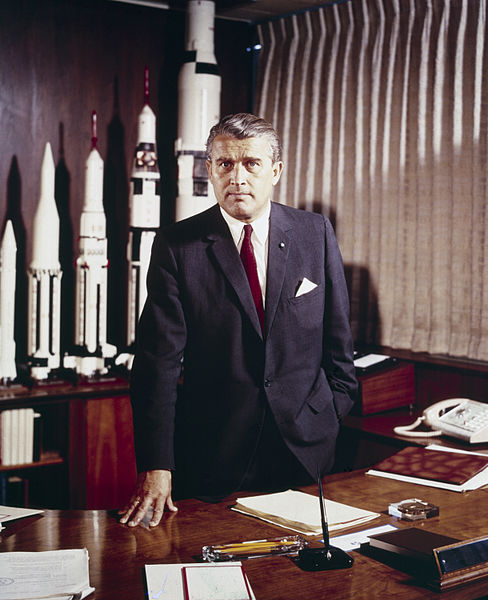
Von
Braun at his desk at Marshall Space Flight Center in
May 1964, with models of the Saturn rocket family
In
his 20s and early 30s, von Braun was the central figure
in Germany's rocket development program, responsible for
the design and realization of the V-2 combat rocket during
World War II. After the war, he and some select members
of his rocket team were taken to the United States as
part of the then-secret Operation Paperclip. Von Braun
worked on the United States Army intermediate range ballistic
missile (IRBM) program before his group was assimilated
by NASA. Under NASA, he served as director of the newly
formed Marshall Space Flight Center and as the chief architect
of the Saturn V launch vehicle, the superbooster that
propelled the Apollo spacecraft to the Moon.[1] According
to one NASA source, he is "without doubt, the greatest
rocket scientist in history".[2] His crowning achievement
was to lead the development of the Saturn V booster rocket
that helped land the first men on the Moon in July 1969.[3]
In 1975 he received the National Medal of Science.
Early
life
Wernher
von Braun was born in Wirsitz, in the Province of Posen,
then a part of the German Empire, and was the second of
three sons. He belonged to an aristocratic family, inheriting
the German title of Freiherr (equivalent to Baron). His
father, conservative civil servant Magnus Freiherr von
Braun (1878–1972), served as a Minister of Agriculture
in the Federal Cabinet during the Weimar Republic. His
mother, Emmy von Quistorp (1886–1959), could trace
her ancestry through both parents to medieval European
royalty, a descendant of Philip III of France, Valdemar
I of Denmark, Robert III of Scotland, and Edward III of
England. Von Braun had a younger brother, also named Magnus
Freiherr von Braun. After Wernher von Braun's Lutheran
confirmation, his mother gave him a telescope, and he
developed a passion for astronomy. The family moved to
Berlin in 1915 where his father worked at the department
of interior. Here, 12-year-old von Braun, inspired by
speed records established by Max Valier and Fritz von
Opel in rocket-propelled cars, caused a major disruption
in a crowded street by detonating a toy wagon to which
he had attached a number of fireworks. He was taken into
custody by the local police until his father came to collect
him.
Wernher
von Braun was an accomplished amateur musician who could
play Beethoven and Bach from memory. Von Braun learned
to play the cello and the piano at an early age and originally
wanted to become a composer. He took lessons from composer
Paul Hindemith. The few pieces of von Braun’s youthful
compositions that exist are reminiscent of Hindemith’s
style.
Beginning
in 1925, von Braun attended a boarding school at Ettersburg
Castle near Weimar where he did not do well in physics
and mathematics. There he acquired a copy of Die Rakete
zu den Planetenräumen (1923) (By Rocket into Interplanetary
Space) (in German) by rocket pioneer Hermann Oberth. In
1928, his parents moved him to the Hermann-Lietz-Internat
(also a residential school) on the East Frisian North
Sea island of Spiekeroog. Space travel had always fascinated
von Braun, and from then on, he applied himself to physics
and mathematics to pursue his interest in rocket engineering.
In
1930, he attended the Technische Hochschule Berlin, where
he joined the Verein für Raumschiffahrt (VfR, the
"Spaceflight Society") and assisted Willy Ley
in his liquid-fueled rocket motor tests in conjunction
with Hermann Oberth. In the spring of 1932, he was graduated
from the Technische Hochschule Berlin with a Diplom degree
in aeronautical engineering. His early exposure to rocketry
convinced him that the exploration of space would require
far more than applications of the current engineering
technology. Wanting to learn more about physics, chemistry,
and astronomy, von Braun entered the Friedrich-Wilhelms-Universität
for post-graduate studies and was graduated with a Dr.
Phil. degree in physics in 1934. He also studied at ETH
Zürich. Although he worked mainly on military rockets
in his later years there, space travel remained his primary
interest.
In
1930, von Braun attended a presentation given by Auguste
Piccard. After the talk the young student approached the
famous pioneer of high-altitude balloon flight, and stated
to him: "You know, I plan on travelling to the
Moon at some time." Piccard is said to have responded
with encouraging words.
He
was greatly influenced by Oberth, of whom he said:
"Hermann Oberth was the first, who when thinking
about the possibility of spaceships grabbed a slide-rule
and presented mathematically analyzed concepts and designs....
I, myself, owe to him not only the guiding-star of my
life, but also my first contact with the theoretical and
practical aspects of rocketry and space travel. A place
of honor should be reserved in the history of science
and technology for his ground-breaking contributions in
the field of astronautics."
German
career
Involvement
with the Nazi regime
Party
membership
Von
Braun had an ambivalent and complex relationship with
the regime of the Third Reich. He officially applied for
membership in the NSDAP on November 12, 1937 and was issued
membership number 5,738,692.
Michael
J. Neufeld, the widely-published author of aerospace history
and the chief of the Space History Division at the Smithsonian's
National Air and Space Museum, wrote that ten years after
Von Braun obtained his Nazi Party membership, the rocket
scientist produced an affidavit for the U.S. Army misstating
the year of his membership, saying falsely:
"In
1939, I was officially demanded to join the National Socialist
Party. At this time I was already Technical Director at
the Army Rocket Center at Peenemünde (Baltic Sea).
The technical work carried out there had, in the meantime,
attracted more and more attention in higher levels. Thus,
my refusal to join the party would have meant that I would
have to abandon the work of my life. Therefore, I decided
to join. My membership in the party did not involve any
political activity."
Whether
von Braun's error with regard to the year was deliberate
or a simple mistake has never been ascertained, although
Neufeld stated he might have lied on the affidavit. Neufeld
further wrote:
"Von
Braun, like other Peenemünders, was assigned to the
local group in Karlshagen; there is no evidence that he
did more than send in his monthly dues. But he is seen
in some photographs with the party's swastika pin in his
lapel – it was politically useful to demonstrate
his membership."
As
for his attitude toward the National Socialist regime
in the late 1930s and early 1940s, there can be little
doubt that he was a loyal, perhaps mildly enthusiastic
subject of Hitler's dictatorship. With the Führer
going from success to success—eliminating unemployment,
tearing up the Versailles Treaty, rearming, reoccupying
the Rhineland, and then in 1938 absorbing Austria and
the Czech Sudetenland without war—there is no doubt
that the regime, and Hitler himself, had become immensely
popular. Von Braun, a German nationalist immersed in a
military environment, doubtlessly found much he could
like about these accomplishments, and little reason to
be disturbed, especially in view of how much money had
been poured into his beloved rocketry as a result of rearmament.
He admitted in a 1952 memoir article that he "fared
relatively rather well under totalitarianism."
Membership
in the Allgemeine SS
Von
Braun joined the Allgemeine SS. In 1947, he gave the U.S.
War Department this explanation:
"In
spring 1940, one SS-Standartenfuehrer (SS-colonel) Mueller
from Greifswald, a bigger town in the vicinity of Peenemuende,
looked me up in my office ... and told me, that Reichsfuehrer
SS Himmler had sent him with the order to urge me to join
the SS. I told him I was so busy with my rocket work that
I had no time to spare for any political activity. He
then told me, that ... the SS would cost me no time at
all. I would be awarded the rank of a[n] "Untersturmfuehrer
(lieutenant) and it were [sic] a very definite desire
of Himmler that I attend his invitation to join.
I asked Mueller to give me some time for reflection. He
agreed.
Realizing that the matter was of highly political significance
for the relation between the SS and the Army, I called
immediately on my military superior ..., Dr. Dornberger.
He informed me that the SS had for a long time been trying
to get their "finger in the pie" of the rocket
work. I asked him what to do. He replied on the spot that
if I wanted to continue our mutual work, I had no alternative
but to join."
Von
Braun joined the organization and was issued membership
number 185,068.
Michael
J. Neufeld writes:
"As
with von Braun's party membership, we have no truly independent
account of what happened, but his story is plausible."
Von
Braun's feelings for the regime may have changed when
he was arrested and accused of being a "communist
sympathizer" who had attempted to sabotage or delay
the weapons program. These charges could have led to the
death penalty for treason. Not helping the matter was
that von Braun had skills as a pilot and had access to
an aircraft, which might have allowed him to escape to
England. (See: Arrest and release by the Nazi regime).
When
shown a picture of him behind Himmler, Braun claimed to
have worn the SS uniform only that one time, but in 2002
a former SS officer at Peenemünde told the BBC that
von Braun had regularly worn the SS uniform to official
meetings. He began as an Untersturmführer (Second
lieutenant) and was promoted three times by Himmler, the
last time in June 1943 to SS-Sturmbannführer (major).
Von Braun claimed this was a technical promotion received
each year regularly by mail.
The
Prussian rocketeer and working under the Nazis
Von
Braun was working on his creative doctorate when the National
Socialist German Workers Party (NSDAP, or Nazi party)
came to power in a coalition government in Germany; rocketry
almost immediately became part of the national agenda.
An artillery captain, Walter Dornberger, arranged an Ordnance
Department research grant for Von Braun, who then worked
next to Dornberger's existing solid-fuel rocket test site
at Kummersdorf. He was awarded a doctorate in physics
(aerospace engineering) on July 27, 1934 from the University
of Berlin for a thesis titled About Combustion Tests;
his doctoral advisor was Erich Schumann. However, this
thesis was only the public part of von Braun's work. His
actual full thesis, Construction, Theoretical, and Experimental
Solution to the Problem of the Liquid Propellant Rocket
(dated April 16, 1934) was kept classified by the army,
and was not published until 1960. By the end of 1934,
his group had successfully launched two rockets that rose
to heights of 2.2 and 3.5 km (2 mi).
At
the time, Germany was highly interested in American physicist
Robert H. Goddard's research. Before 1939, German scientists
occasionally contacted Goddard directly with technical
questions. Wernher von Braun used Goddard's plans from
various journals and incorporated them into the building
of the Aggregat (A) series of rockets. The A-4 rocket
would become well known as the V-2. In 1963, von Braun
reflected on the history of rocketry, and said of Goddard's
work: "His rockets ... may have been rather crude
by present-day standards, but they blazed the trail and
incorporated many features used in our most modern rockets
and space vehicles."[8] Goddard confirmed his work
was used by von Braun in 1944, shortly before the Nazis
began firing V-2s at England. A V-2 crashed in Sweden
and some parts were sent to an Annapolis lab where Goddard
was doing research for the Navy. If this was the so-called
Bäckebo Bomb, it had been procured by the British
in exchange for Spitfires; Annapolis would have received
some parts from them. Goddard is reported to have recognized
components he had invented, and inferred that his brainchild
had been turned into a weapon.
There
were no German rocket societies after the collapse of
the VfR, and civilian rocket tests were forbidden by the
new Nazi regime. Only military development was allowed
and to this end, a larger facility was erected at the
village of Peenemünde in northern Germany on the
Baltic Sea. Dornberger became the military commander at
Peenemünde, with von Braun as technical director.
In collaboration with the Luftwaffe, the Peenemünde
group developed liquid-fuel rocket engines for aircraft
and jet-assisted takeoffs. They also developed the long-range
A-4 ballistic missile and the supersonic Wasserfall anti-aircraft
missile.

Walter
Dornberger, Friedrich Olbricht, Wilhelm von Leeb,
and von Braun at Peenemünde, 1941
On
December 22, 1942, Adolf Hitler signed the order approving
the production of the A-4 as a "vengeance weapon"
and the group developed it to target London. Following
von Braun's July 7, 1943 presentation of a color movie
showing an A-4 taking off, Hitler was so enthusiastic
that he personally made von Braun a professor shortly
thereafter. In Germany at this time, this was an exceptional
promotion for an engineer who was only 31 years old.
.jpg)
Schematic
of the A4/V2
By
that time the British and Soviet intelligence agencies
were aware of the rocket program and von Braun's team
at Peenemünde. Over the nights of August 17 and 18,
1943 RAF Bomber Command's Operation Hydra dispatched raids
on the Peenemünde camp consisting of 596 aircraft
and dropped 1,800 tons of explosives. The facility was
salvaged and most of the science team remained unharmed;
however, the raids killed von Braun's engine designer
Walter Thiel and Chief Engineer Walther, and the rocket
program was delayed.
See also: Bombing of Peenemünde in World War II
The
first combat A-4, renamed the V-2 (Vergeltungswaffe 2
"Retaliation/Vengeance Weapon 2") for propaganda
purposes, was launched toward England on September 7,
1944, only 21 months after the project had been officially
commissioned. Von Braun's interest in rockets was specifically
for the application of space travel, which led him to
say on hearing the news from London: "The rocket
worked perfectly except for landing on the wrong planet."
He described it as his "darkest day".[citation
needed] However, satirist Mort Sahl is often credited
with mocking von Braun with the paraphrase "I aim
at the stars, but sometimes I hit London". In fact
that line appears in the film I Aim at the Stars, a 1960
biopic on von Braun.
Experiments
with rocket aircraft
During
1936 von Braun's rocketry team working at Kummersdorf
investigated installing liquid-fuelled rockets in aircraft.
Ernst Heinkel enthusiastically supported their efforts,
supplying a He 72 and later two He 112s for the experiments.
Late in 1936 Erich Warsitz was seconded by the RLM to
Wernher von Braun and Ernst Heinkel, because he had been
recognized as one of the most experienced test-pilots
of the time, and because he also had an extraordinary
fund of technical knowledge.[30] After von Braun familiarized
Warsitz with a test-stand run, showing him the corresponding
apparatus in the aircraft, he asked:
"Are
you with us and will you test the rocket in the air? Then,
Warsitz, you will be a famous man. And later, we will
fly to the moon – with you at the helm!"
In
June 1937, at Neuhardenberg (a large field about 70 km
(43 mi) east of Berlin, listed as a reserve airfield in
the event of war), one of these latter aircraft was flown
with its piston engine shut down during flight by test
pilot Erich Warsitz, at which time it was propelled by
von Braun’s rocket power alone. Despite the wheels-up
landing and having the fuselage on fire, it proved to
official circles that an aircraft could be flown satisfactorily
with a back-thrust system through the rear.

A
regular He 112
At
the same time, Hellmuth Walter's experiments into hydrogen
peroxide-based rockets were leading towards light and
simple rockets that appeared well-suited for aircraft
installation. Also the firm of Hellmuth Walter at Kiel
had been commissioned by the RLM to build a rocket engine
for the He 112, so there were two different new rocket
motor designs at Neuhardenberg: whereas von Braun’s
engines were powered by alcohol and liquid oxygen, Walter
engines had hydrogen peroxide and calcium permanganate
as a catalyst. Von Braun’s engines used direct combustion
and created fire, the Walter devices used hot vapours
from a chemical reaction, but both created thrust and
provided high speed. The subsequent flights with the He
112 used the Walter-rocket instead of von Braun's; it
was more reliable, simpler to operate and the dangers
to test-pilot Erich Warsitz and machine were less.
Slave
labor
SS
General Hans Kammler, who as an engineer had constructed
several concentration camps including Auschwitz, had a
reputation for brutality and had originated the idea of
using concentration camp prisoners as slave laborers in
the rocket program. Arthur Rudolph, chief engineer of
the V-2 rocket factory at Peenemünde, endorsed this
idea in April 1943 when a labor shortage developed. More
people died building the V-2 rockets than were killed
by it as a weapon. Von Braun admitted visiting the plant
at Mittelwerk on many occasions, and called conditions
at the plant "repulsive," but claimed never
to have witnessed any deaths or beatings, although it
had become clear to him by 1944 that deaths had occurred.
He denied ever having visited the Mittelbau-Dora concentration
camp itself, where 20,000 died from illness, beatings,
hangings and intolerable working conditions.
On
August 15, 1944, von Braun wrote a letter to Albin Sawatzki,
manager of the V-2 production, admitting that he personally
picked labor slaves from the Buchenwald concentration
camp, who, he admitted 25 years later in an interview,
had been in a "pitiful shape".
In
Wernher von Braun: Crusader for Space, numerous statements
by von Braun show he was aware of the conditions but felt
completely unable to change them. A friend quotes von
Braun speaking of a visit to Mittelwerk:
It is hellish. My spontaneous reaction was to talk to
one of the SS guards, only to be told with unmistakable
harshness that I should mind my own business, or find
myself in the same striped fatigues!... I realized that
any attempt of reasoning on humane grounds would be utterly
futile.
When
asked if von Braun could have protested against the brutal
treatment of the slave laborers, von Braun team member
Konrad Dannenberg told The Huntsville Times, "If
he had done it, in my opinion, he would have been shot
on the spot."
Others
claim von Braun engaged in brutal treatment or approved
of it. Guy Morand, a French resistance fighter who was
a prisoner in Dora, testified in 1995 that after an apparent
sabotage attempt:
Without even listening to my explanations, [von Braun]
ordered the Meister to have me given 25 strokes...Then,
judging that the strokes weren't sufficiently hard, he
ordered I be flogged more vigorously...von Braun made
me translate that I deserved much more, that in fact I
deserved to be hanged...I would say his cruelty, of which
I was personally a victim, are, I would say, an eloquent
testimony to his Nazi fanaticism.
Robert
Cazabonne, another French prisoner, testified that von
Braun stood by and watched as prisoners were hung by chains
from hoists. Von Braun claimed he "never saw any
kind of abuse or killing" and only "heard rumors...that
some prisoners had been hanged in the underground galleries".
Arrest
and release by the Nazi regime
According
to André Sellier, a French historian and survivor
of the Mittelbau-Dora concentration camp, Himmler had
von Braun come to his Hochwald HQ in East Prussia in February
1944. To increase his power-base within the Nazi regime,
Heinrich Himmler was conspiring to use Kammler to gain
control of all German armament programs, including the
V-2 program at Peenemünde. He therefore recommended
that von Braun work more closely with Kammler to solve
the problems of the V-2. Von Braun claimed to have replied
that the problems were merely technical and he was confident
that they would be solved with Dornberger's assistance.
Von
Braun had been under SD surveillance since October 1943.
A report stated that he and his colleagues Riedel and
Gröttrup were said to have expressed regret at an
engineer's house one evening that they were not working
on a spaceship and that they felt the war was not going
well; this was considered a "defeatist" attitude.
A young female dentist who was an SS spy reported their
comments. Combined with Himmler's false charges that von
Braun was a communist sympathizer and had attempted to
sabotage the V-2 program, and considering that von Braun
regularly piloted his government-provided airplane that
might allow him to escape to England, this led to his
arrest by the Gestapo.
The
unsuspecting von Braun was detained on March 14 (or March
15), 1944 and was taken to a Gestapo cell in Stettin (now
Szczecin, Poland), where he was held for two weeks without
knowing the charges against him. Through the Abwehr in
Berlin, Dornberger obtained von Braun's conditional release
and Albert Speer, Reichsminister for Munitions and War
Production, convinced Hitler to reinstate von Braun so
that the V-2 program could continue. Quoting from the
"Führerprotokoll" (the minutes of Hitler's
meetings) dated May 13, 1944 in his memoirs, Speer later
relayed what Hitler had finally conceded: "In the
matter concerning B. I will guarantee you that he will
be exempt from persecution as long as he is indispensable
for you, in spite of the difficult general consequences
this will have."
Surrender
to the Americans
The
Soviet Army was about 160 km (99 mi) from Peenemünde
in the spring of 1945 when von Braun assembled his planning
staff and asked them to decide how and to whom they should
surrender. Afraid of the well-known Soviet cruelty to
prisoners of war, von Braun and his staff decided to try
to surrender to the Americans. Kammler had ordered relocation
of von Braun's team to central Germany; however, a conflicting
order from an army chief ordered them to join the army
and fight. Deciding that Kammler's order was their best
bet to defect to the Americans, von Braun fabricated documents
and transported 500 of his affiliates to the area around
Mittelwerk, where they resumed their work. For fear of
their documents being destroyed by the SS, von Braun ordered
the blueprints to be hidden in an abandoned mine shaft
in the Harz mountain range.
While
on an official trip in March, von Braun suffered a complicated
fracture of his left arm and shoulder after his driver
fell asleep at the wheel. His injuries were serious, but
he insisted that his arm be set in a cast so he could
leave the hospital. Due to this neglect of the injury,
he had to be hospitalized again a month later where his
bones had to be re-broken and re-aligned.
In
April, as the Allied forces advanced deeper into Germany,
Kammler ordered the science team to be moved by train
into the town of Oberammergau in the Bavarian Alps where
they were closely guarded by the SS with orders to execute
the team if they were about to fall into enemy hands.
However, von Braun managed to convince SS Major Kummer
to order the dispersion of the group into nearby villages
so that they would not be an easy target for U.S. bombers.
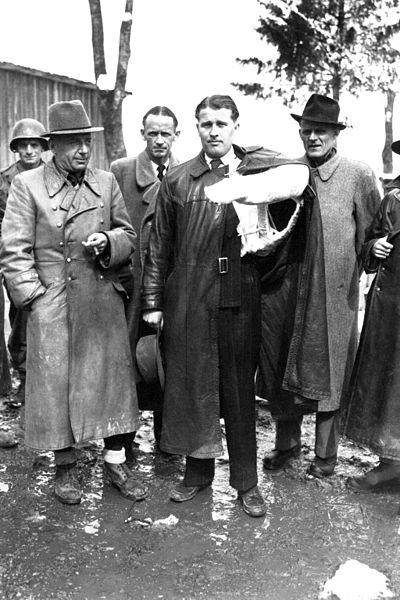
Von
Braun, with his arm in a cast from an auto accident, surrendered
to the Americans just before this May 3, 1945 photo.
On
May 2, 1945, upon finding an American private from the
U.S. 44th Infantry Division, von Braun's brother and fellow
rocket engineer, Magnus, approached the soldier on a bicycle,
calling out in broken English: "My name is Magnus
von Braun. My brother invented the V-2. We want to surrender."
After the surrender, von Braun spoke to the press:
"We
knew that we had created a new means of warfare, and the
question as to what nation, to what victorious nation
we were willing to entrust this brainchild of ours was
a moral decision more than anything else. We wanted to
see the world spared another conflict such as Germany
had just been through, and we felt that only by surrendering
such a weapon to people who are guided by the Bible could
such an assurance to the world be best secured."
The
American high command was well aware of how important
their catch was: von Braun had been at the top of the
Black List, the code name for the list of German scientists
and engineers targeted for immediate interrogation by
U.S. military experts. On June 19, 1945, two days before
the scheduled handover of the area to the Soviets, US
Army Major Robert B. Staver, Chief of the Jet Propulsion
Section of the Research and Intelligence Branch of the
U.S. Army Ordnance Corps in London, and Lt Col R. L. Williams
took von Braun and his department chiefs by jeep from
Garmisch to Munich. The group was flown to Nordhausen,
and was evacuated 40 miles (64 km) southwest to Witzenhausen,
a small town in the American Zone, the next day. Von Braun
was briefly detained at the "Dustbin" interrogation
center at Kransberg Castle where the elite of the Third
Reich's economy, science and technology were debriefed
by U.S. and British intelligence officials. Initially
he was recruited to the U.S. under a program called "Operation
Overcast," subsequently known as Operation Paperclip.
There is evidence, however, that British intelligence
and scientists were the first to interview him in depth,
eager to gain information that they knew US officials
would deny them. The team included the young L.S. Snell,
then the leading British rocket engineer, later chief
designer of Rolls Royce and inventor of Concorde's engines.
What information they gained remained top secret, from
the Americans and other allies. [source - L.S. Snell -
Memoir]
American
career
U.S.
Army career
On
June 20, 1945, the U.S. Secretary of State approved the
transfer of von Braun and his specialists to America;
however this was not announced to the public until October
1, 1945.[50] Von Braun was among those scientists for
whom the U.S. Joint Intelligence Objectives Agency created
false employment histories and expunged Nazi Party memberships
and regime affiliations from the public record. Once “bleached”
of their Nazism, the US Government granted the scientists
security clearance to work in the United States.
The
first seven technicians arrived in the United States at
New Castle Army Air Field, just south of Wilmington, Delaware,
on September 20, 1945. They were then flown to Boston
and taken by boat to the Army Intelligence Service post
at Fort Strong in Boston Harbor. Later, with the exception
of von Braun, the men were transferred to Aberdeen Proving
Ground in Maryland to sort out the Peenemünde documents,
enabling the scientists to continue their rocketry experiments.
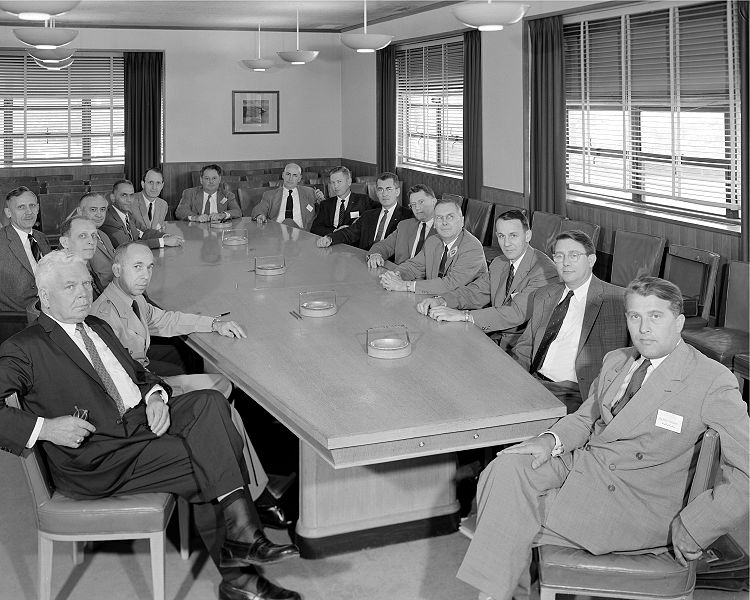
Wernher
von Braun at a meeting of NACA's
Special Committee on Space Technology
Finally,
von Braun and his remaining Peenemünde staff (see
List of German rocket scientists in the United States)
were transferred to their new home at Fort Bliss, a large
Army installation just north of El Paso. Von Braun would
later write he found it hard to develop a "genuine
emotional attachment" to his new surroundings. His
chief design engineer Walther Reidel became the subject
of a December 1946 article "German Scientist Says
American Cooking Tasteless; Dislikes Rubberized Chicken,'
exposing the presence of von Braun's team in the country
and drawing criticism from Albert Einstein and John Dingell.
Requests to improve their living conditions such as laying
linoleum over their cracked wood flooring were rejected.
Von Braun remarked that "...at Peenemünde we
had been coddled, here you were counting pennies..."
At the age of 26, von Braun had thousands of engineers
who answered to him, but was now answering to "pimply"
26 year-old Major Jim Hamill who possessed an undergraduate
degree in engineering. His loyal Germans still addressed
him as Herr Professor, but Hamill addressed him as Wernher
and never bothered to respond to von Braun's request for
more materials, and every proposal for new rocket ideas
was dismissed.
While
there, they trained military, industrial and university
personnel in the intricacies of rockets and guided missiles.
As part of the Hermes project, they helped refurbish,
assemble, and launch a number of V-2s that had been shipped
from Germany to the White Sands Proving Ground in New
Mexico. They also continued to study the future potential
of rockets for military and research applications. Since
they were not permitted to leave Fort Bliss without military
escort, von Braun and his colleagues began to refer to
themselves only half-jokingly as "PoPs," "Prisoners
of Peace."
In
1950, at the start of the Korean War, von Braun and his
team were transferred to Huntsville, Alabama, his home
for the next 20 years. Between 1950 and 1956, von Braun
led the Army's rocket development team at Redstone Arsenal,
resulting in the Redstone rocket, which was used for the
first live nuclear ballistic missile tests conducted by
the United States. This led to development of the first
high-precision inertial guidance system on the Redstone
rocket.
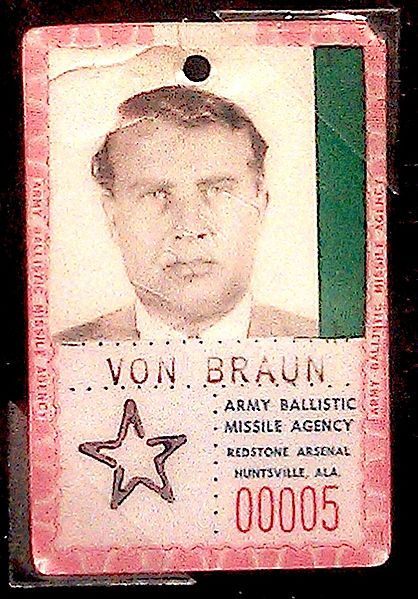
von
Braun's badge at ABMA (1957)
As
director of the Development Operations Division of the
Army Ballistic Missile Agency (ABMA), von Braun, with
his team, then developed the Jupiter-C, a modified Redstone
rocket. The Jupiter-C successfully launched the West's
first satellite, Explorer 1, on January 31, 1958. This
event signaled the birth of America's space program.
Despite
the work on the Redstone rocket, the twelve years from
1945 to 1957 were probably some of the most frustrating
for von Braun and his colleagues. In the Soviet Union,
Sergei Korolev and his team of scientists and engineers
plowed ahead with several new rocket designs and the Sputnik
program, while the American government was not very interested
in von Braun's work or views and only embarked on a very
modest rocket-building program. In the meantime, the press
tended to dwell on von Braun's past as a member of the
SS and the slave labor used to build his V-2 rockets.
Popular
concepts for a human presence in space
Repeating
the pattern he had established during his earlier career
in Germany, von Braun – while directing military
rocket development in the real world – continued
to entertain his engineer-scientist's dream of a future
world in which rockets would be used for space exploration.
However, instead of risking being sacked, he now was increasingly
in a position to popularize these ideas. The May 14, 1950
headline of The Huntsville Times ("Dr. von Braun
Says Rocket Flights Possible to Moon") might have
marked the beginning of these efforts. These disclosures
rode a moonflight publicity wave that was created by the
two 1950 U.S. science fiction films, Destination Moon
and Rocketship X-M.
In
1952, von Braun first published his concept of a manned
space station in a Collier's Weekly magazine series of
articles entitled "Man Will Conquer Space Soon!".
These articles were illustrated by the space artist Chesley
Bonestell and were influential in spreading his ideas.
Frequently von Braun worked with fellow German-born space
advocate and science writer Willy Ley to publish his concepts,
which, unsurprisingly, were heavy on the engineering side
and anticipated many technical aspects of space flight
that later became reality.
The
space station (to be constructed using rockets with recoverable
and reusable ascent stages) would be a toroid structure,
with a diameter of 250 feet (76 m); this built on the
concept of a rotating wheel-shaped station introduced
in 1929 by Herman Potoc(nik in his book The Problem of
Space Travel – The Rocket Motor. The space station
would spin around a central docking nave to provide artificial
gravity, and would be assembled in a 1,075 mile (1,730
km) two-hour, high-inclination Earth orbit allowing observation
of essentially every point on earth on at least a daily
basis. The ultimate purpose of the space station would
be to provide an assembly platform for manned lunar expeditions.
More than a decade later, the movie version of 2001: A
Space Odyssey would draw heavily on the design concept
in its visualization of an orbital space station.
Von
Braun envisaged these expeditions as very large-scale
undertakings, with a total of 50 astronauts travelling
in three huge spacecraft (two for crew, one primarily
for cargo), each 49 m (160.76 ft) long and 33 m (108.27
ft) in diameter and driven by a rectangular array of 30
rocket propulsion engines. Upon arrival, astronauts would
establish a permanent lunar base in the Sinus Roris region
by using the emptied cargo holds of their craft as shelters,
and would explore their surroundings for eight weeks.
This would include a 400 km (249 mi) expedition in pressurized
rovers to the crater Harpalus and the Mare Imbrium foothills.
At
this time von Braun also worked out preliminary concepts
for a manned mission to Mars that used the space station
as a staging point. His initial plans, published in The
Mars Project (1952), had envisaged a fleet of ten spacecraft
(each with a mass of 3,720 metric tons), three of them
unmanned and each carrying one 200-ton winged lander in
addition to cargo, and nine crew vehicles transporting
a total of 70 astronauts. Gigantic as this mission plan
was, its engineering and astronautical parameters were
thoroughly calculated. A later project was much more modest,
using only one purely orbital cargo ship and one crewed
craft. In each case, the expedition would use minimum-energy
Hohmann transfer orbits for its trips to Mars and back
to Earth.
Before
technically formalizing his thoughts on human spaceflight
to Mars, von Braun had written a science fiction novel,
set in 1980, on the subject. According to his biographer,
Erik Bergaust, the manuscript was rejected by no less
than 18 publishers. Von Braun later published small portions
of this opus in magazines, to illustrate selected aspects
of his Mars project popularizations. The complete manuscript,
titled Project MARS: A Technical Tale, did not appear
as a printed book until December 2006.
In
the hope that its involvement would bring about greater
public interest in the future of the space program, von
Braun also began working with Walt Disney and the Disney
studios as a technical director, initially for three television
films about space exploration. The initial broadcast devoted
to space exploration was Man in Space, which first went
on air on March 9, 1955, drawing 42 million viewers and
unofficially the second-highest rated television show
in American history.
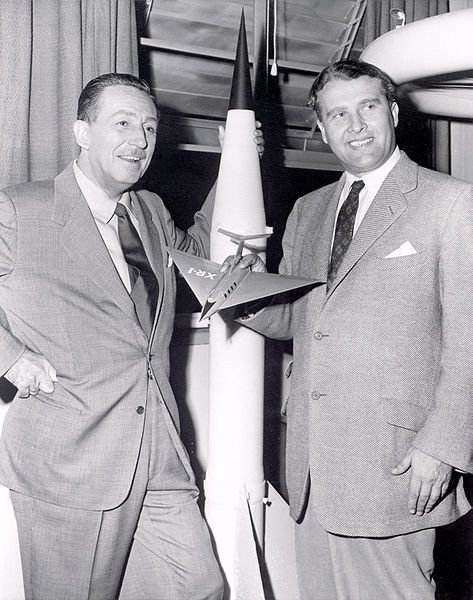
Walt
Disney and von Braun, seen in 1954 holding a model of
his
passenger ship, collaborated on a series of three educational
films.
Later
(in 1959) von Braun published a short booklet — condensed
from episodes that had appeared in This Week Magazine
before — describing his updated concept of the first
manned lunar landing. The scenario included only a single
and relatively small spacecraft — a winged lander
with a crew of only two experienced pilots who had already
circumnavigated the moon on an earlier mission. The brute-force
direct ascent flight schedule used a rocket design with
five sequential stages, loosely based on the Nova designs
that were under discussion at this time. After a night
launch from a Pacific island the first three stages would
bring the spacecraft (with the two remaining upper stages
attached) to terrestrial escape velocity, with each burn
creating an acceleration of 8–9 times standard gravity.
Residual propellant in the third stage would be used for
the deceleration intended to commence only a few hundred
kilometers above the landing site in a crater near the
lunar north pole. The fourth stage provided acceleration
to lunar escape velocity while the fifth stage would be
responsible for a deceleration during return to the Earth
to a residual speed that allows aerocapture of the spacecraft
ending in a runway landing, much in the way of the Space
Shuttle. One remarkable feature of this technical tale
is that the engineer Wernher von Braun anticipated a medical
phenomenon that would become apparent only years later:
being a veteran astronaut with no history of serious adverse
reactions to weightlessness offers no protection against
becoming unexpectedly and violently spacesick.
Concepts
for orbital warfare
Von
Braun developed and published his space station concept
during the very "coldest" time of the Cold War,
when the U.S. government for which he worked put the containment
of the Soviet Union above everything else. The fact that
his space station – if armed with missiles that could
be easily adapted from those already available at this
time – would give the United States space superiority
in both orbital and orbit-to-ground warfare did not escape
him. Although von Braun took care to qualify such military
applications as "particularly dreadful" in his
popular writings, he elaborated on them in several of
his books and articles. This much less peaceful aspect
of von Braun's "drive for space" has recently
been reviewed by Michael J. Neufeld from the Space History
Division of the National Air and Space Museum in Washington.
NASA
career
Werner von Braun during Apollo 11 launch
The
U.S. Navy had been tasked with building a rocket to lift
satellites into orbit, but the resulting Vanguard rocket
launch system was unreliable. In 1957, with the launch
of Sputnik 1, there was a growing belief within the United
States that America lagged behind the Soviet Union in
the emerging Space Race. American authorities then chose
to utilize von Braun and his German team's experience
with missiles to create an orbital launch vehicle, Wernher
von Braun had originally proposed in 1954 but had been
denied.
NASA
was established by law on July 29, 1958. One day later,
the 50th Redstone rocket was successfully launched from
Johnston Atoll in the south Pacific as part of Operation
Hardtack I. Two years later, NASA opened the Marshall
Space Flight Center at Redstone Arsenal in Huntsville,
and the ABMA development team led by von Braun was transferred
to NASA. In a face-to-face meeting with Herb York at the
Pentagon, von Braun made it clear he would go to NASA
only if development of the Saturn was allowed to continue.
Presiding from July 1960 to February 1970, von Braun became
the center's first Director.
Von
Braun's early years at NASA were not without some disappointments.
One of those was the "infamous four inch flight"
during which the first unmanned Mercury-Redstone rocket
only rose a few inches before settling back onto the launch
pad. It was later determined that the launch failure was
the result of a "power plug with one prong shorter
than the other because a worker filed it to make it fit."
Because of the difference in the length of one prong the
launch system detected the difference in the power disconnection
as a "cut-off signal to the engine." The system
stopped the launch, and the incident created a "nadir
of morale in Project Mercury."

Charles W. Mathews, von Braun, George Mueller, and Lt.
Gen. Samuel C. Phillips in the
Launch Control Center following the successful Apollo
11 liftoff on July 16, 1969
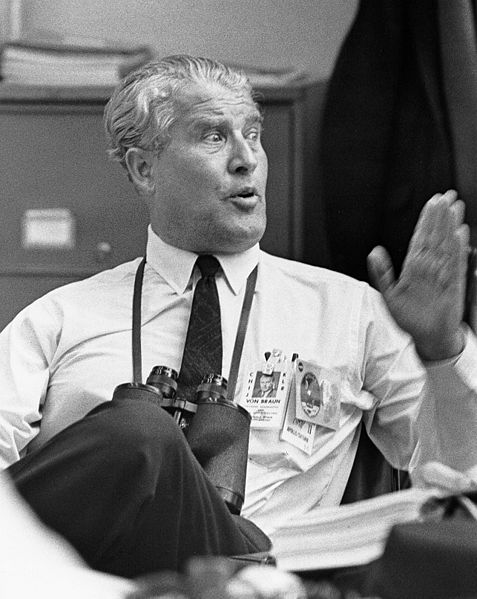
Werner
von Braun during Apollo 11 launch
The
Marshall Center's first major program was the development
of Saturn rockets to carry heavy payloads into and beyond
Earth orbit. From this, the Apollo program for manned
moon flights was developed. Wernher von Braun initially
pushed for a flight engineering concept that called for
an Earth orbit rendezvous technique (the approach he had
argued for building his space station), but in 1962 he
converted to the lunar orbit rendezvous concept that was
subsequently realized. During Apollo, he worked closely
with former Peenemünde teammate, Kurt H. Debus, the
first director of the Kennedy Space Center. His dream
to help mankind set foot on the Moon became a reality
on July 16, 1969 when a Marshall-developed Saturn V rocket
launched the crew of Apollo 11 on its historic eight-day
mission. Over the course of the program, Saturn V rockets
enabled six teams of astronauts to reach the surface of
the Moon.

Von
Braun with President Kennedy at Redstone Arsenal in 1963
During
the late 1960s, von Braun was instrumental in the development
of the U.S. Space & Rocket Center in Huntsville. The
desk from which he guided America's entry in the Space
Race remains on display there.
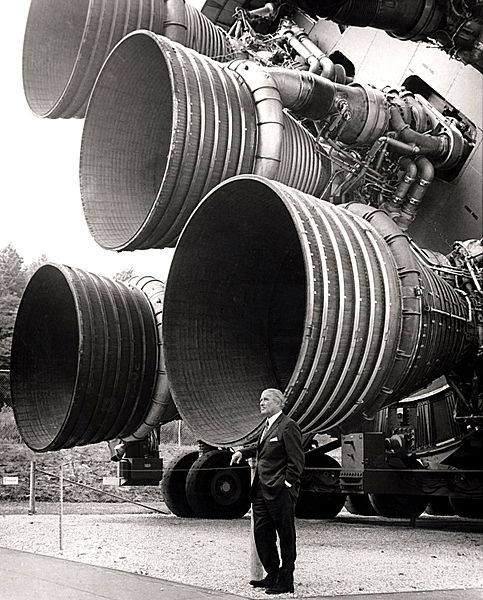
Von
Braun with the F-1 engines of the Saturn Vfirst stage
at the US Space and Rocket Center
During
the local summer of 1966–67, von Braun participated
in a field trip to Antarctica, organized for him and several
other members of top NASA management. The goal of the
field trip was to determine whether the experience gained
by US scientific and technological community during the
exploration of Antarctic wastelands would be useful for
the manned exploration of space. Von Braun was mainly
interested in management of the scientific effort on Antarctic
research stations, logistics, habitation and life support,
and in using the barren Antarctic terrain like the glacial
dry valleys to test the equipment that one day would be
used to look for signs of life on Mars and other worlds.
In
an internal memo dated January 16, 1969, von Braun had
confirmed to his staff that he would stay on as a center
director at Huntsville to head the Apollo Applications
Program. A few months later, on occasion of the first
moon-landing, he publicly expressed his optimism that
the Saturn V carrier system would continue to be developed,
advocating manned missions to Mars in the 1980s.
However,
on March 1, 1970, von Braun and his family relocated to
Washington, D.C., when he was assigned the post of NASA's
Deputy Associate Administrator for Planning at NASA Headquarters.
After a series of conflicts associated with the truncation
of the Apollo program, and facing severe budget constraints,
von Braun retired from NASA on May 26, 1972. Not only
had it become evident by this time that his and NASA's
visions for future U.S. space flight projects were incompatible;
it was perhaps even more frustrating for him to see popular
support for a continued presence of man in space wane
dramatically once the goal to reach the moon had been
accomplished.
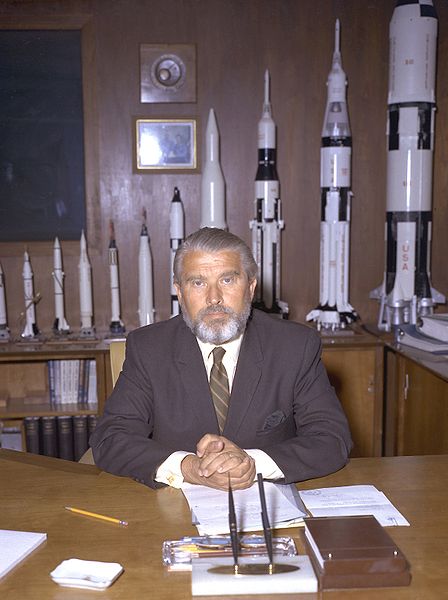
Still
with his rocket models, von Braun is pictured in his
new office at NASA headquarters in 1970
Dr.
von Braun also developed the idea of a Space Camp that
would train children in fields of science and space technologies
as well as help their mental development much the same
way sports camps aim at improving physical development.
Career
after NASA
After
leaving NASA, von Braun became Vice President for Engineering
and Development at the aerospace company, Fairchild Industries
in Germantown, Maryland on July 1, 1972.
In
1973, a routine health check revealed kidney cancer, which
during the following years, could not be controlled by
surgery. Von Braun continued his work to the extent possible,
which included accepting invitations to speak at colleges
and universities as he was eager to cultivate interest
in human spaceflight and rocketry, particularly with students
and a new generation of engineers.
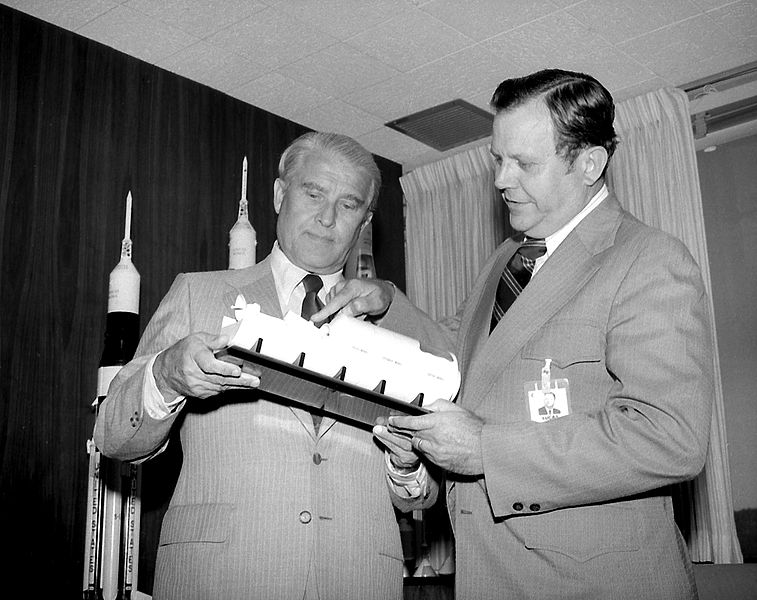
Von Braun and William R. Lucas, the first and third Marshall
Space
Flight Center directors, viewing a Spacelab model in 1974
Von
Braun helped establish and promote the National Space
Institute, a precursor of the present-day National Space
Society, in 1975, and became its first president and chairman.
In 1976, he became scientific consultant to Lutz Kayser,
the CEO of OTRAG, and a member of the Daimler-Benz board
of directors. However, his deteriorating health forced
him to retire from Fairchild on December 31, 1976. When
the 1975 National Medal of Science was awarded to him
in early 1977, he was hospitalized, and unable to attend
the White House ceremony.
Personal
life
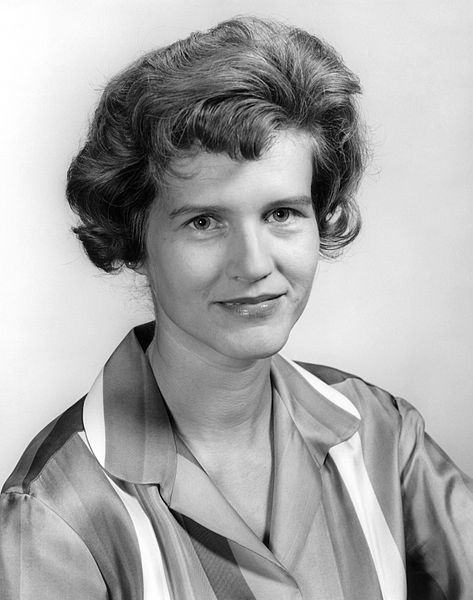
Maria von Braun, wife of Wernher von Braun
During
his stay at Fort Bliss, von Braun mailed a marriage proposal
to 18-year-old German heiress Maria Luise von Quistorp
(born June 10, 1928), his cousin on his mother's side.
On March 1, 1947, having received permission to go back
to Germany and return with his bride, he married her in
a Lutheran church in Landshut, Germany. He and his bride,
as well as his father and mother, returned to New York
on March 26, 1947.
On
December 9, 1948, the von Brauns' first daughter, Iris
Careen, was born at Fort Bliss Army Hospital. The von
Brauns had two more children, Margrit Cécile in
1952 and Peter Constantine in 1960. On April 15, 1955,
von Braun became a naturalized citizen of the United States.
Death
Grave of Wernher von Braun in Ivy Hill Cemetery (Alexandria,
Virginia)
On
June 16, 1977, Wernher von Braun died of pancreatic cancer
in Alexandria, Virginia, at the age of 65. He was buried
at the Ivy Hill Cemetery in Alexandria, Virginia.
Source:
http://en.wikipedia.org/wiki/Wernher_von_Braun
